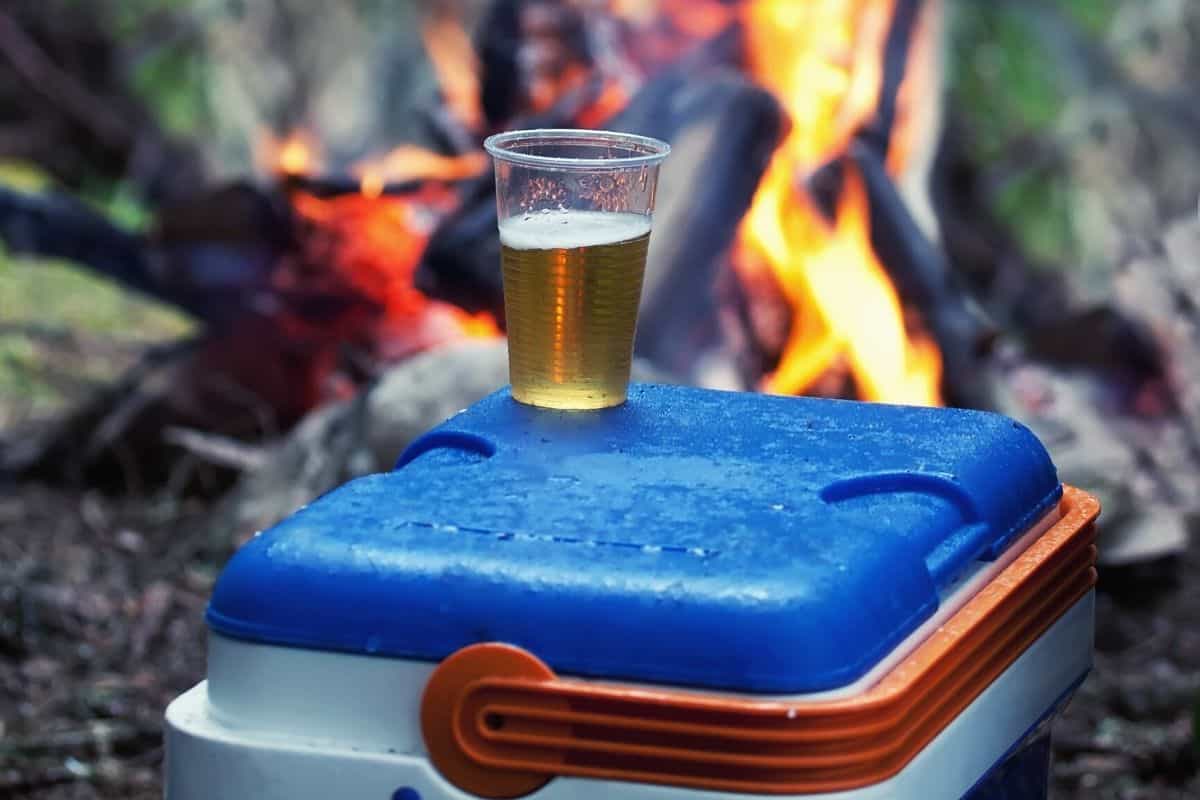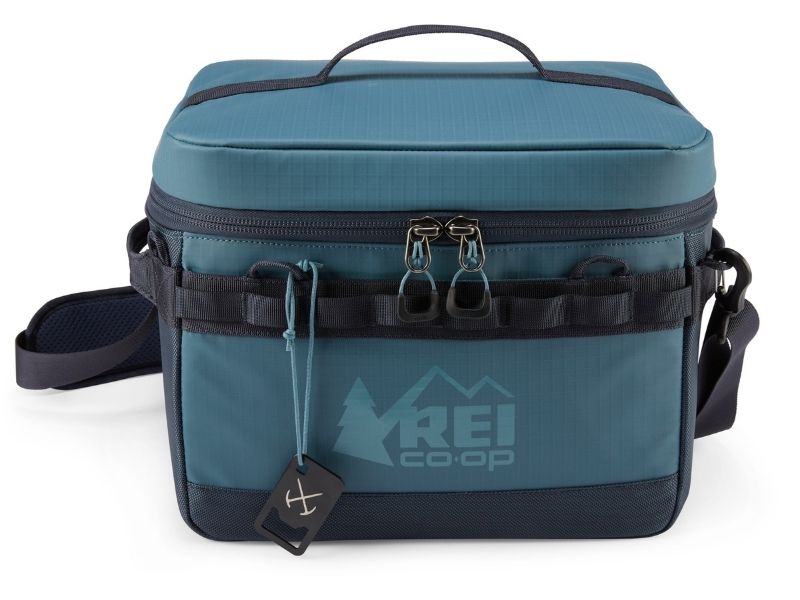The camping market is blessed with such a wide array of kickass coolers that choosing between them can be a time-consuming and tricky affair. To save you the hassle, we’ve tested a number of the best cooler brands over the last seven years and year after year have picked the Yeti Tundra 65 as our overall favorite cooler.
If the Yeti Tundra doesn’t suit you, then our list of 11 high-end coolers has something for everyone, from oversized hard-sided options for longer camping trips to portable soft-sided models for backcountry adventures. The list includes the Yeti Tundra 65, RTIC 45, Coleman Xtreme 5-Day, RovR RollR 60, Yeti Coolers Roadie 24, Dometic CFX3 75, Hydro Flask 22L Unbound, Pelican Dayventure 22, REI Co-Op Cool Haul 12, Orca, and Igloo.
To help you choose the right cooler for you, we provide a detailed buying guide that explains how Cooler Capacity, cooling performance, weight and portability, Latching Systems, Drain Systems, Organization, Accessories, Bear-Resistant Ratings, and Warranty should all factor into your decision.
Table of Contents
Quick Recommendations
-
Editor’s Choice:
Yeti Tundra 65
“A virtually indestructible cooler that boasts awesome cooling performance, a bear-resistant construction, and first-class features.” -
Runner Up:
RTIC 45
“The RTIC is reasonably priced, as durable as they come, boasts excellent ice-retention, and has all the handy add-ons you’d expect to find on a top-tier hard-shell cooler.” -
Best Budget:
Coleman Xtreme 5-Day 70qt
“This simple, high-capacity ice chest isn’t as tough as rotomolded models but insulates remarkably well for the price.” -
Best Wheeled Cooler:
RovR RollR 60
“An outstandingly well-made, rotomolded cooler with giant all-terrain tires to make transportation easier.” -
Best Small Cooler:
Yeti Roadie 24
“The Tundra in miniature, the Roadie is a great pick for campers who want long-term cooling without the weight, bulk, and price tag of a high-capacity model.” -
Best Electric:
Dometic CFX3 75
“The closest you can get to the performance of your fridge-freezer back home.” -
Best Soft Cooler:
Hydro Flask 22L Unbound
“As comfortable as a regular daypack but capable of keeping its contents cool for long weekends in the wilds.” -
Best Backpack Cooler:
Pelican Dayventure Backpack Cooler
“An extremely rugged, burly pack that’s ideal for solo hikers or couples on day hikes or overnight trips.” -
Best Value Soft-Sided Cooler:
REI Co-op Cool Haul 12
“A highly portable, low-cost option that’s capable of keeping food and drink cold over long weekends.” -
Honorable Mention:
Orca 40
“Made with the same top-notch materials and designs as all Orca coolers, but pricey for the size.” -
Best Disposable Cooler:
Igloo Recool
“A 16-quart cooler that you can responsibly dispose of with ease. One for the eco-conscious camper.”
What is the Best Cooler for Camping?
While testing suggested the Yeti Tundra 65 was the best overall camping cooler, we feel that each cooler on the list below merits its place under different scenarios.
- Yeti Tundra 65
- RTIC 45
- Coleman Xtreme 5-Day
- RovR RollR 60
- Yeti Coolers Roadie 24
- Dometic CFX3 75
- Hydro Flask 22L Unbound
- Pelican Dayventure 22L
- REI Co-Op Cool Haul 12
- Orca 40
- Igloo Recool
Yeti Tundra 65
Editor’s ChoiceCapacity: 61 qt. ⸱ Weight: 27 lbs. ⸱ Ice retention: I4 days ⸱ Other sizes: 28 to 329 qt.
The Tundra’s 65-quart capacity, combined with its ability to keep ice frozen for 4 days, makes it the perfect camping cooler for extended trips for larger groups.
Capacity and ice retention, though, aren’t the only things that make this the best ice chest for camping.
The Tundra is also one of the toughest coolers on the market. It’s made with 3 inches of pressure-injected insulation and nigh-on indestructible, rotomolded walls.
The sheer size of the Tundra means it isn’t the easiest to transport, but it’s convenient and user-friendly in every other way. The military-grade polyester rope handles are wrapped in easy-grip rubber, a dry storage basket lets you separate beers from burgers, and the “Vortex” drainage system makes emptying melted water a breeze.
Compared to cheaper large camping coolers, the Tundra boasts a few non-standard features that make it the best hard-sided cooler out there for performance and practicality. The most notable are the interlocking hinges and “ColdLock” gasket that together provide an air-tight seal, as well as burly locking lid latches, non-slip feet, and molded tie-down points.
PROs
- High capacity
- Rotomolded construction
- Compatible with dry ice
- Certified bear-resistant
- 5-year warranty
CONs
- Heavy
- Pricey
Bottom-Line: The gold standard of camping coolers. Period.
RTIC 45
Runner UpCapacity: 45 qt. ⸱ Weight: 29 lbs. ⸱ Ice retention: 10 days ⸱ Other sizes: 20 to 145 qt.
The RTIC 45 is an awesome cooler if want outstanding cooling power but don’t want the bulk (or price!) of an extra-large cooler.
The RTIC 45 has the second-best cooling time of all the non-electric models on our list, keeping ice frozen up to a hugely impressive ten days – 6 days more than our review’s winner, the Tundra.
This is mainly thanks to its rotomolded construction and 3” insulated walls. The interlocking hinges, high-quality gasket, and thick rubber latches also play their part in making it an awesome insulator.
While the ideal cooler capacity depends on your group size and trip duration, we’re big fans of the RTIC’s 45-quart volume. This makes it a little more portable than the giants on our list (the Tundra and Dometic CFX3) and suitable for both weekend trips for larger groups or longer trips for couples and small families.
The RTIC doesn’t have any dividers or dry goods trays, but its other features hit the spot. There’s a pair of molded tie-down slots, non-slip feet, heavy-duty rope handles with a rubber grip, an easy-lift drain handle, a freezer-style lid gasket, and a “Rapid V-Drain System” that takes care of drainage efficiently.
PROs
- Awesome ice retention
- Can be carried by one person
- Bear-resistant
- Rotomolded construction and thick insulation
- Nice features
CONs
- Only a 1-year warranty
- Very heavy for the size
Bottom-Line: An affordable, durable, and versatile camp cooler that offers virtually unrivaled cooling power.
Coleman Xtreme 5-Day
Best BudgetCapacity: 70 qt. ⸱ Weight: 7.1 lbs. ⸱ Ice retention: Up to 5 days (at temps below 90 degrees) ⸱ Other sizes: 28-120 qt.
Our testers agreed that the Coleman Xtreme 5-Day is the best cooler for camping out there for group campers on a budget.
This 70-quart camping cooler has the second largest capacity on our list, after the Dometic CFX3. For such a cheap product, moreover, it also boasts respectable ice retention. The “5-day” claim is, according to our testers, a bit of a stretch, but there’s no doubt it will keep your eats/drinks cold over a long weekend with careful use.
The Xtreme also has a few cool features. First up, there’s the Have-A-Seat lid – a lid capable of moonlighting as a chair whilst fulfilling its standard role as a closure for the cooling chamber. There are also four cup holders – a feature that’s not likely to seal any deals, but surprisingly handy nonetheless.
PROs
- Affordable
- Sit-on lid with 4 cup holders
- Good cooling power
- Can be used as a chair
- Drain plug
CONs
- Doesn’t maintain ice as well as top-end models (lots of ice packs required!)
- Not as durable as other coolers
- No locking latches in lid
Bottom-Line: A low-cost option that comes up a little short in the ice-retention stakes when compared with its pricier competitors but is good enough for weekend trips with friends and family.
RovR RollR 60
Best Wheeled CoolerCapacity: 60 qt. ⸱ Weight: 49 lbs. ⸱ Ice retention: Up to 10 days ⸱ Other sizes: 45 & 80 qt.
The RovR RollR 60 is the perfect cooler for campers who don’t want to haul 50+ pounds of plastic, ice, and edibles from their car to your camping site. With its burly off-road wheels, you can roll them there instead!
This cooler performs well in every metric, but its main selling point is the duo of 9-inch, all-terrain rubber wheels and burly pull handle that allows you to transport heavy loads over rough terrain with ease. Needless to say, this feature makes the RollR the most portable model on our list.
Wheels aside, the RollR is one of the best hard coolers we’ve ever used. It uses a similar rotomolded construction to the Tundra and high-density LLDPE plastic/polyurethane foam insulation. In layman’s terms, this means it’s tough as hell and one of the best insulators in the game.
PROs
- Burly all-terrain wheels
- Side-prepping board
- Optional cup holders and bike mount (yep, you read that right!)
- Excellent cooling power
CONs
- Pricey
- Heavy
Bottom-Line: A pricey but highly portable and robust camping cooler that’s ideal if you have to cover any distance between your car and campsite.
Yeti Coolers Roadie 24
Best Small CoolerCapacity: 24 qt. ⸱ Weight: 13 lbs. ⸱ Ice retention: N/A ⸱ Other sizes: N/A
The Roadie 24 is a great choice of cooler for shorter trips, if you have fewer mouths to feed, or if you just want a top-tier camping cooler that’s smaller than heavyweights like the Tundra 65.
The Roadie, in short, is the Tundra in miniature. It has the same rotomolded construction, similarly superb ice retention capacity, and the same high-quality gasket, latches, and hinges.
While the Roadie’s 24-quart capacity means it’s a little too small for groups or multi-day trips, it weighs just 13 lbs and is small enough to squeeze in behind your car’s driver’s seat. This YETI cooler was updated in 2020 and the latest version is tall enough to accommodate wine bottles and also has a burly shoulder strap to help with transportation.
PROs
- Lightweight
- Great cooling capacity
- Tall enough for wine bottles
- Bear-resistant
- Rotomolded construction
CONs
- Low capacity
- Pricey for the size
Bottom-Line: A tough, reliable option from one of the best cooler brands – perfect for camping couples, small families, and day trips.
Dometic CFX3 75
Best Electric CoolerCapacity: 66 qt. ⸱ Weight: 61 lbs. ⸱ Ice retention: Infinite! ⸱ Other sizes: N/A
The Dometic CFX3 is our top pick if you are looking for a portable camping mini-fridge that performs just as well as your fridge-freezer at home.
The CFX3 electric-powered cooler weighs a whopping 61 lbs. and costs a small fortune. But if you plan on having multi-day car camping trips at sites with electric hookups, are serious about keeping your drinks and food cold, and have $ to burn, this is the cooler for you.
The CFX3’s build is nearly as rugged as the top-end, non-electric hard-siders on our list, and to make up the difference it has burly fender frames for added protection.
Compared to those other models, however, it is a hands-down winner for long-term outdoor adventures. Why? Firstly, it has dual storage compartments with independent temperature control that allow for simultaneous cooling and freezing, and it can deep-freeze contents down to -7 degrees. And secondly, because it runs on electricity, its ice-retention time is infinite!
The CFX3 also has a few add-ons that make it a better pick than other electric coolers, most notably a high-resolution color display and app-based performance monitoring and temperature control.
PROs
- Say goodbye to melting ice!
- Large capacity
- Dual storage compartments with independent temperature control
- Heavy-duty construction
- 5-year warranty
CONs
- Expensive
- Heavy
Bottom-Line: One of the best coolers out there for multi-day trips and the best car-camping cooler for trips to sites with a power source.
Hydro Flask 22L Unbound
Best Soft CoolerCapacity: 19.35 qt. ⸱ Weight: 3 lbs. ⸱ Ice retention: Keeps contents cold for up to 48 hours ⸱ Other sizes: 15L (13.2 qt.)
The Hydro Flask Unbound’s light weight and portability make it a solid choice of cooler if you plan on venturing a little further from the roadside when camping.
What we loved most about this portable cooler in testing was that it’s nearly as comfortable to carry as some of our favorite backpacks and yet it can keep our drinks and food cold for up to a respectable 24 hours.
The Unbound weighs just 3 lbs., making it a whole 6 lbs. lighter than our list’s other backpack cooler, the Pelican Coolers Dayventure. It also has a durable waterproof shell, leak-proof zippers and sealed seams that make it watertight, and a food-grade BPA-free liner. There’s also a “True Access” hinged lid for easy access and cleaning, and multiple gear pockets for non-edible/drinkable gear.
The only complaint we have with the Unbound is the price. If you can stomach that, you’ll be getting a product that’s built to last, capable of keeping things cold over a weekend camping trip, and more suitable for far-flung adventures than almost any other option out there.
PROs
- Lightweight
- Comfortable to carry
- 5-year warranty
- Good cooling time
CONs
- Expensive
Bottom-Line: A sleek and stylish backpack that’s a comfortable carry and capable of keeping your food fresh on weekend trips. One of the best coolers out there for backcountry adventuring.
Pelican Dayventure 22L
Best Backpack CoolerCapacity: 16.19 qt. ⸱ Weight: 9.3 lbs. ⸱ Ice retention: 12 hours ⸱ Other sizes: 13L (11.4 qt.)
The Pelican Dayventure backpack is our favorite camping cooler for single-day trips. It’s robust, leak-proof, easy to carry, and can keep ice frozen for a modest but sufficient 12 hours.
This pack is made with 840-denier, double-coated TPU and has a compression-molded base for added durability. These materials make it among the most rugged soft-sided packs on the market and far more likely to survive use and abuse than either the Hydro Flask Outbound or REI Cool Haul.
The Dayventure also has a wealth of value-adding features, most notably leak-resistant zippers, a wide roll-top opening, a daisy chain that allows you to lash gear to the pack’s exterior, adjustable chest straps, and nicely padded shoulder straps.
The compartmentalized design also allows you to separate different foodstuffs and keep things organized. The bottom compartment is big enough for a 6-pack of beer and the upper compartment is large enough for a feast for a family of four.
PROs
- Comfortable shoulder straps
- Puncture-resistant materials
- 3-year warranty
- Compression-molded base
- Leak-resistant zippers
CONs
- Pricey
- Heavy for the size
Bottom-Line: A well-made backpack that’s slightly heavy but otherwise a great option for backcountry camping adventures.
REI Co-Op Cool Haul 12
Best Value Soft-Sided CoolerCapacity: 15.8 qt. ⸱ Weight: 3 lbs. 6 oz. ⸱ Ice retention: Keeps drinks chilled for up to 65 hours ⸱ Other sizes: 18 & 24 qt.
The REI Co-Op Cool Haul is an excellent entry-level option for campers looking for a simple, effective soft-walled cooler that won’t break the bank. This tote-style cooler bag is one of the cheapest options on our list but offers performance on a par with many far pricier soft coolers.
The Cool Haul consists of an insulated, leakproof inner box, a tough ripstop nylon shell, and an adjustable shoulder strap for easy transportation. There’s also daisy-chain webbing that can be used to lash other outdoor gear to the outside of the bag and an external pocket for small essentials.
In terms of cooling capacity, the Cool Haul lags far behind the hard-sided coolers on our list, and the Dayventure and Hydro Flask Unbound are both better options if you plan on carrying ice. Nevertheless, it’s still a good option if you’re traveling without frozen goods that have to be packed in with plenty of ice.
PROs
- Affordable
- Lightweight
- Sustainable materials
- Bottle opener included
CONs
- Exterior isn’t waterproof
- Only big enough for a one-night camping excursion
Bottom-Line: A budget portable cooler that performs just as well as many models that cost twice as much.
ORCA 40
Honorable MentionThe ORCA 40 is a solid option for anyone looking for a premium cooler that’s built to last a lifetime and deliver outstanding cooling performance. This cooler’s 40-quart capacity makes it great for weekends away or longer solo trips
This ORCA cooler has a rotomolded construction with integrated insulation for optimal cooling. While other hard-sided coolers have similar designs, our testers confirmed that the brand’s 10-day cooling power claim held up in practice, which is mightily impressive. Also impressive is ORCA’s lifetime warranty, though the walls are so tough that we don’t imagine you’ll need it!
The only quibbles we have with this cooler are the price and the latch system. The YETI Tundra 45 retails for a little less and yet gives you 5 more quarts of space, while the latches are among the fiddliest we’ve ever used.
PROs
- Lifetime warranty
- Durable
- Excellent cooling performanc
CONs
- Expensive
- Poor latches
Bottom-Line: Excellent ice retention and tough as nails, but too pricey for the size.
Igloo Recool
Best Disposable CoolerThe Igloo Recooler is the perfect choice of cooler for eco-conscious campers due to its entirely recyclable materials.
This Igloo cooler is made with compostable and biodegradable material (recycled paper and alkyl ketene dimer). Despite this, it can keep your ice cool for up to 12 hours and water fresh for up to five days. It’s also reusable, even if you’ll have to take extra care not to damage the walls.
The Recool boasts 16 quarts of storage space, which is good for six to eight large drinks or a few dinners. It’s small enough to carry under an arm and has two molded carry handles on the side, as well as four cup holders up top.
While it has its limitations (durability, cooling performance, size), the Recools eco credentials and bargain price make it a contender for our Best Cheap Cooler award.
PROs
- Cheap
- Reusable
- Eco-friendly
CONs
- Fragile
- Limited cooling capacity
Bottom-Line: Short on strength and cooling performance but cheap, eco-friendly, and good enough for day trips.
Ice Chest Comparison Table
| Product Name | Type | Capacity | Ice Retention | Weight |
|---|---|---|---|---|
| Yeti Tundra 65 | Hard-Sided | 61 qt | Up to 4 days | 27 lbs |
| RTIC 45 | Hard-Sided | 45 qt | Up to 10 days | 29 lbs |
| Coleman Xtreme 5-Day | Hard-Sided | 70 qt | Up to 5 days | 7.1 lbs |
| RovR RollR 60 | Wheeled Cooler | 60 qt | Up to 10 days | 49 lbs |
| Yeti Coolers Roadie 24 | Hard-Sided | 24 qt | Up to 48 hours | 13 lbs |
| Dometic CFX3 75 | Electric Cooler | 66 qt | Infinite | 61 lbs |
| Hydro Flask 22L Unbound | Soft Cooler | 19.35 qt | Up to 48 hours | 3 lbs |
| Pelican Dayventure 22L | Backpack Cooler | 16.19 qt | Up to 12 hours | 9.3 lbs |
| REI Co-Op Cool Haul 12 | Soft-Sided Cooler | 15.8 qt | Up to 65 hours | 3 lbs 6 oz |
| ORCA 40 | Hard-Sided | 40 qt | Up to 5 days | 26 lbs |
| Igloo Recool | Disposable Cooler | 16 qt | Up to 12 hours | 1.6 lbs |
Top Choices by Category
Soft-sided: REI Co-Op Haul 12, Pelican Dayventure, and Hydro Flask 22L Unbound
Hard-sided: Yeti Tundra 65, Yeti Roadie 24, Coleman Cooler Xtreme, RovR RollR 60, Dometic CFX3, and RTIC 45
Electric: Dometic CFX3
Bear Resistant: Yeti Tundra 65, RTIC 45, RovR RollR 60, and Yeti Roadie 24
Budget: Coleman Xtreme 5-Day 70qt, REI Co-Op Haul 12
Types of Cooler
Hard, soft, or electric? Below, we offer a brief overview of the advantages and disadvantages of each type of cooler.
Soft Coolers
- Lightweight
- Easier to transport – many models have backpack/messenger-bag-style shoulder straps
- Extra “give” in fabric lets you squeeze more items in and make the most of the usable space
- (Mostly) cheaper than hard-sided coolers
- Poorer ice retention than hard-sided coolers
- Less durable
Our list has 3 soft-sided coolers, the REI Co-Op Haul 12, the Pelican Dayventure, and the Hydro Flask 22L Unbound. Of the three, the Unbound offers the best ice retention and the Dayventure the best organization, but both cost more than twice as much as the Haul 12, which is a perfectly good option for day trips.
Hard Coolers
- Superior ice retention
- Durable
- Often certified bear-resistant
- High capacity models available
- Pricey, for the most part (the Coleman Xtreme is a notable exception)
- Heavy
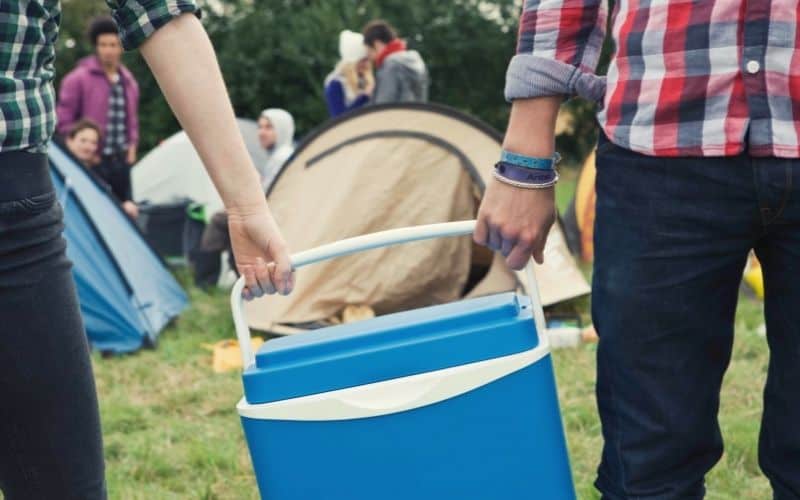
Our list has 6 hard-sided coolers: the Tundra 65, Roadie 24, the Coleman Cooler Xtreme, RovR RollR 60, Dometic CFX3, and the RTIC 45.
Electric Coolers
- Awesome ice retention (just like your freezer at home!)
- Require a power source
- (Darned) pricey!
- Heavy
Our list’s lone electric cooler is the Dometic CFX3.
Hard, Soft, or Electric?
Choosing between a hard, soft, and electric cooler comes down to three things: the duration of your camping trip, where you plan on going, and the size of your camping crew.
For long-stay trips when you have access to an electrical hook-up, then an electric cooler is hands-down the winner due to its infinite cooling power and high capacity. The downside? They cost so much you may have to rob a bank or remortgage your home to buy one…
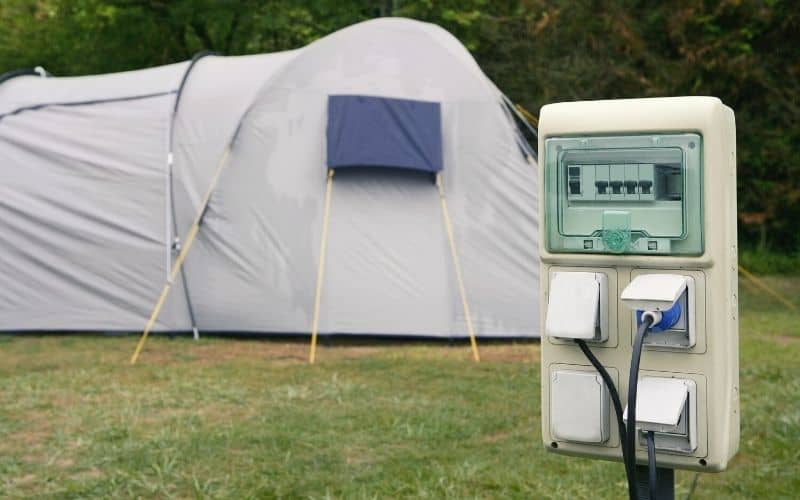
The next best thing for multi-day trips are rotomolded coolers like the Tundra, Roadie, and RovR RollR 60, all of which can keep your food, drinks, and ice cold for multiple days. These coolers, however, are expensive, far heavier than soft-sided models, and awkward to carry.
Soft-siders are the most portable option. They’re light, malleable, and come with handy shoulder straps that let you carry them like a regular backpack or tote. Most models are also far cheaper than similarly sized hard-siders.
On the downside, soft-walled coolers have poorer ice retention, so they’re usually only good for day trips or overnight stays.
How To Choose an Outdoor Cooler?
When choosing a reliable cooler for your next camping adventure, consider the following criteria before you buy.
- Cooler Capacity
- Cooling Performance & Ice Retention
- Weight & Portability
- Latching System
- Drain System
- Organization
- Accessories and Add-Ons
- Bear-Resistant Ratings
- Warranty
Cooler Capacity
Your cooler’s capacity is a crucial consideration when choosing because this metric dictates how much food and drink it can hold. What size you need depends on how many people you’re camping with, how big your appetites are, and the duration of your camping trip.
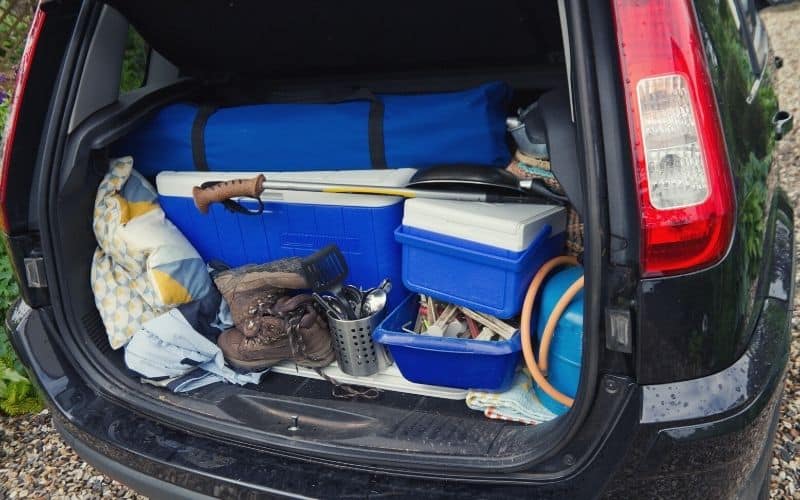
Below, we’ve added an at-a-glance overview of cooler capacities and their suitability for different group sizes and trip durations. Because so many variables come into play (food type, ice-to-contents ratio, the size of your appetites), these are best viewed as “ballpark” estimates.
- Small (10-35 quarts) – good for a day trip for 2-4 people or an overnight camping trip for 1-3 people
- Medium (35-55 quarts) – these are compact enough to be loaded into a car trunk and can be carried by one person
- Large (55-75 quarts) – good for two or more people traveling for multiple days, or weekend trips for groups of 5 or 6
- Extra Large (75+ quarts) – ideal for large groups for a 3 to 4-day camping trip or smaller groups on longer trips
Cooling Performance & Ice Retention
Cooling performance is all-important when choosing a cooler, as this refers to how well (and how long) a cooler can keep your edibles and drinkables cool or frozen. It’s mainly determined by the type of insulation used and the seal.
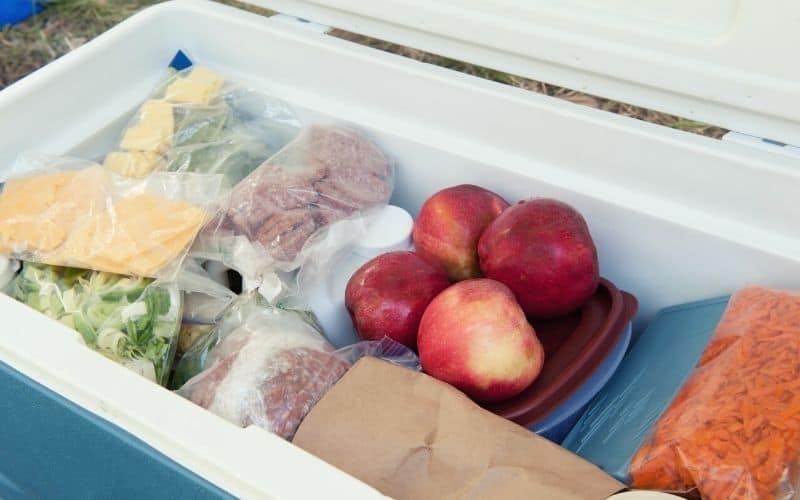
Simply put, better, thicker insulation means a cooler cooler.
All of the top-rated coolers we tested had one thing in common: around 3-inches of high-density polyurethane foam sandwiched between a pair of burly, rotomolded, compound resin or polypropylene walls, as seen on the RTIC 45, Tundra, and RollR 60.
For proof of this, we need only look at the less impressive ice-retention times of coolers with less insulation, like the Coleman 5-Day and the soft-walled coolers above.
A cooler’s cooling capacity depends on its ability to keep cool air in and ambient air out. This being so, the quality of the seal is also of the utmost importance.
While the seals used on all the models we tested are effective and well-made, they are constructed of less durable materials (silicone) than the body of the cooler and so it’s worth noting that these will degrade over time. When this happens, the cooling capacity will drop drastically, so be prepared to purchase a new one a few years down the line.
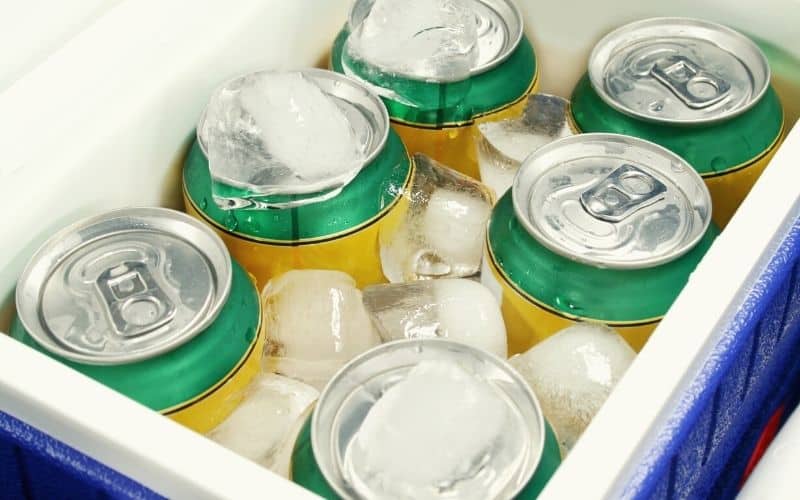
Manufacturers typically indicate how long their coolers can keep their contents cold. The time frames they suggest, however, are best taken with a pinch of salt. Why? First, marketing people are never shy about inflating ice-retention times to boost sales. Secondly, several variables can impact a cooler’s ability to keep your stuff cold.
The most important of these variables are:
- Ambient temperature (the “maximum ice retention” of some models only applies in cool temperatures)
- Sunlight exposure
- The ice-to-contents ratio (i.e. how much ice you pack compared to food)
- Whether or not you pre-chilled the cooler and/or its contents (pre-chilling the cooler can add hours to its cooling capacity)
- How often you open the lid
- The size of your ice cubes or ice blocks (larger cubes melt more slowly)
- The type of ice you use (regular or dry – dry ice aids with cooling power but isn’t compatible with all coolers)*
Of all the non-electric models on our list, the RTIC 45, which can keep ice frozen for a whopping 10 days, offers the best cooling capacity.
*The Tundra is the only model on our list that is compatible with dry ice.
Weight And Portability
Depending on whether you are car camping or have miles to cover on foot before setting up camp, the weight of your cooler may be a critical concern.
Once you’ve loaded it with all your food, drinks, and the ice that keeps them cool you could be looking at a 60-pound load, which ain’t ideal unless you happen to bench press small vehicles on your lunch break or have a personal Sherpa to do the carrying.
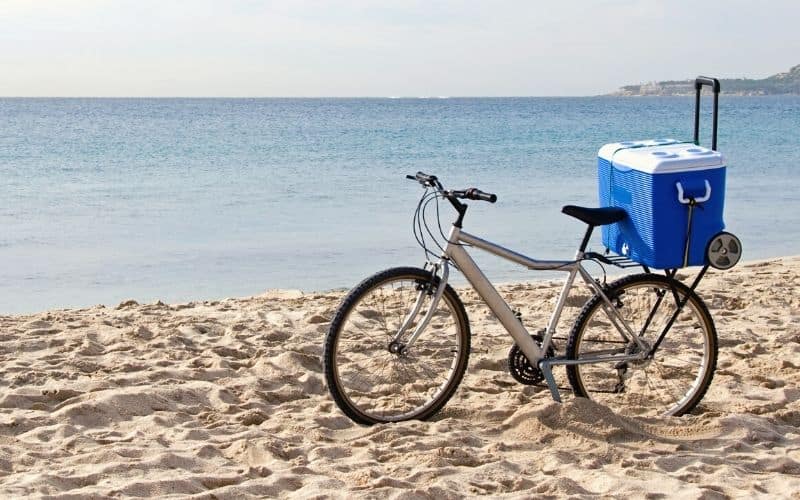
If you don’t have a Sherpa or daily vehicle-hoisting routine then you have 3 options:
1) Choose a soft-sider – models like the REI Cool Haul and Hydro Flask Unbound weigh around three pounds.
2) Choose a cooler with wheels, like the RovR RollR rolling cooler.
3) Compromise by opting for a model with a lower capacity or poorer cooling power.
Wheeled coolers and soft-siders are the most portable options. Soft-siders are not only lighter, but almost always have backpack-style shoulder straps, chest straps, and/or hip belts to aid carrying, which makes them the best coolers for backcountry trips.
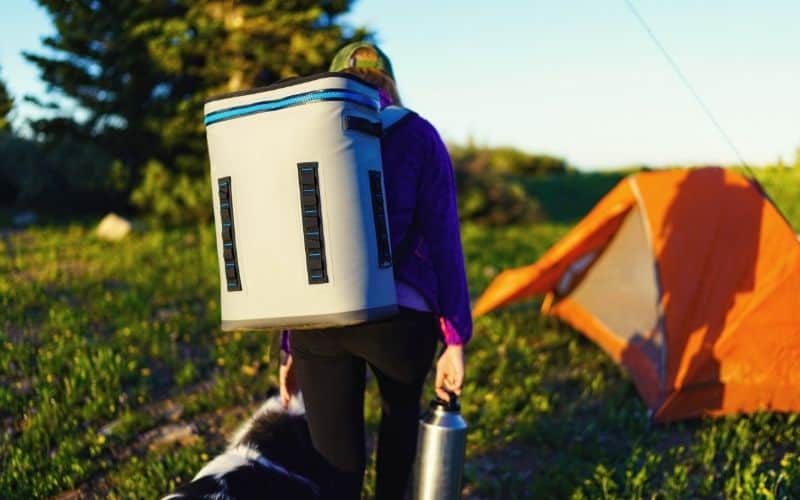
Wheeless hard-sided coolers are the least portable due to their weight, rigid construction, and unwieldy dimensions. The Tundra, for example, weighs 27 pounds empty and measures 30.5 x 17.4 x 16 inches.
Latching System
When deciding which cooler to buy, the latching system is an important feature to consider. This component helps to keep a tight seal between the lid and the storage chamber, which locks cool air in and keeps ambient air out, and also prevent spillage during transportation.
Cheaper coolers, like the Coleman Xtreme, have no latch. This means you have to take care while you’re on the road to ensure the lid doesn’t pop open and then weigh the lid down with a rock/human/other objects when at camp.
Drain System
Drainage systems are used to meltwater from your cooler when adding fresh ice or at the end of your trip. As such, having one that’s easy to use is a major plus.
All of the hard coolers on our list have drainage holes/spigots, though our testers were particularly big fans of the RTIC 45’s “Rapid V-Drain” system, which is just a little easier to use than the rest.
Most soft coolers aren’t blessed with drainage systems but do have removable inners (REI Cool Haul) or wide-mouth, hinged openings (Hydro Flask Unbound) that simplify post-trip cleaning.
Organization
Organization is an important factors to consider when buying a cooler because it helps boost your cooler’s efficiency and lets you separate different foodstuffs.
Most coolers are mere empty boxes, but some have storage trays, shelves, or compartments that divide the overall capacity into two or three parts. This has two main benefits.
Firstly, it allows you to keep your food separate from your beverages, or keep certain foodstuffs like meat, poultry, and fish away from others. Secondly, keeping things organized means you’ll spend less time fishing around inside trying to locate what you need, which improves cooling capacity by reducing exposure to warmer air.
Accessories And Add-Ons
A couple of non-standard add-ons can enhance the overall convenience and user-friendliness of a cooler. With hard coolers, things like drink holders, integrated handles (as opposed to rope handles), a built-in bottle opener, and anti-slip rubber feet are well worth having. With soft coolers, look for exterior pockets, daisy chains, attached bottle openers, and carabiner clips.
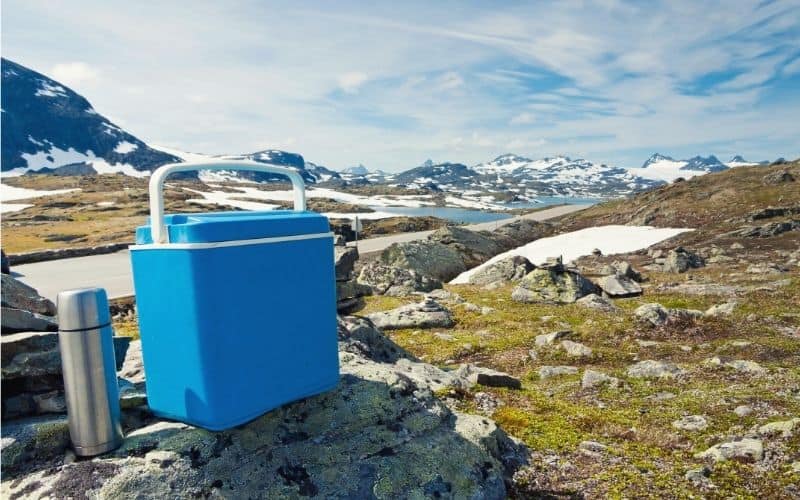
Bear-Resistant Ratings
If you plan on camping in bear country, having a bear-resistant cooler is a must.
Some coolers on our list are certified as bear-resistant by the Interagency Grizzly Bear Committee. While not a 100% guarantee that the product cannot be opened or destroyed by a bear, it does mean it’s less likely and tells you the cooler is also less likely to leak any scents that might attract bears to your campsite.
Need a bear-resistant cooler? Check out the Yeti Tundra 65, RTIC 45, RollR 60, and Yeti Roadie 24.
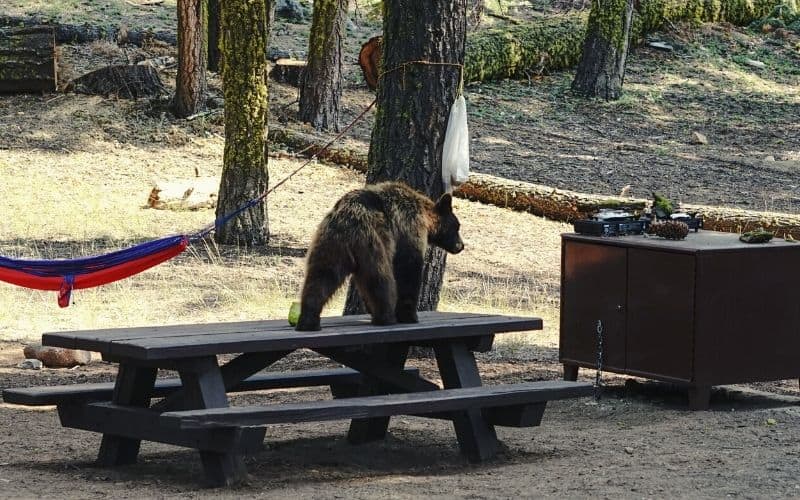
Warranties
It’s always wise to choose a cooler with a good warrant. Warranties do two things. First, they give you added peace of mind knowing that your pricey purchase will be replaced or repaired if it breaks. Secondly, they demonstrate that the manufacturer has faith in their product’s durability.
Best Camping Cooler: The Final Verdict
Our favorite cooler on the market is the Yeti Tundra 65. This robust hard-sided model has too many practical and performance-enhancing features to repeat again! This is reflected in the price tag, though, so if you are on a tight budget you can’t go wrong with the Coleman Xtreme 5-day. It has good cooling power for its price and even has a cooling drain. It is, however, lacking a latch so you do need to be more careful with it.
Want to go electric? Then our top pick is the Dometic CFX3. This is very much at the top end of the price spectrum but with its rugged build, dual compartments with independent temperature control, and infinite ice-retention time it is worth the money if you do long-term camping with an electrical supply.
If you liked our article, let us know in the comments box below. And if you’d like to share it with your friends, share away!
